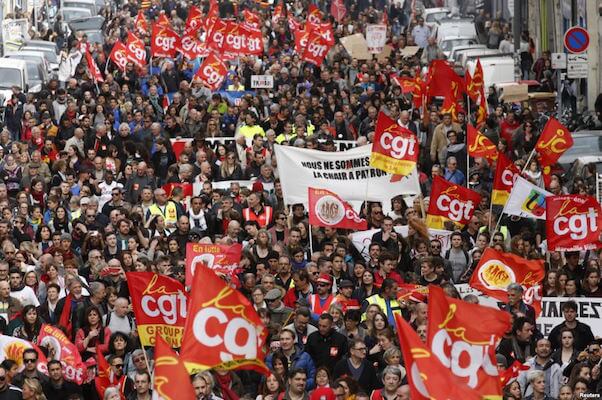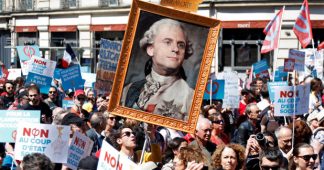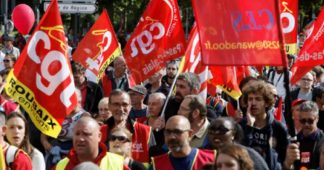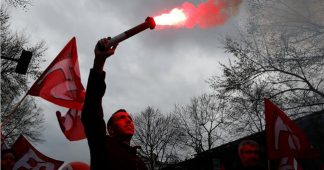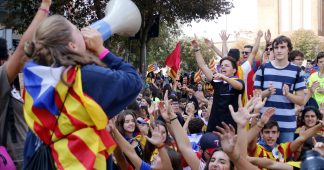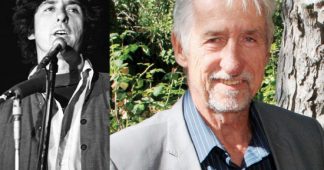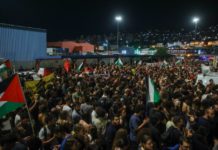1968 was one of those extraordinary years when millions of people were involved in trying to change the world for the better. Hall Greenland writes that the year’s most compelling events took place in May and June on the streets of France.
The world was shaken by an unprecedented wave of protests and rebellions against imperialism, racism, social injustice and the lack of real democracy. 1968 has been compared to 1848 because of the sheer number of countries shaken to their foundations.
The year began in February with the Tet offensive in Vietnam. Despite the presence of more than half a million American troops and the unprecedented bombing of that small, poor country, the fighters of the National Liberation Front of South Vietnam stormed into every town and city in Vietnam to show they were not beaten. They even captured and briefly occupied the heavily fortified US embassy in Saigon.
Such heroism and endurance inspired a worldwide movement of solidarity and hope.
It ushered in a year of widespread democratic engagement and what has been called the beginning of the revolution in everyday life. From 1968 onwards we were to hear that slogan which has never gone away: The personal is political.
It was a year captured in extraordinary images.
- The photos of the carnage in Vietnam, of women and children fleeing a napalm attack on their village. Of a resistance fighter being executed in the street by the Saigon police chief.
- Those of Tommy Smith and John Carlos, standing on the podium at the Mexico Olympics after they came first and third in the 200 metres sprint, holding their black-gloved fists aloft in a black power salute. And standing with them, wearing a Civil Rights badge in solidarity, was the Australian athlete Peter Norman who had run second.
- The images of young people swarming all over Soviet tanks in Prague that had invaded Czechosovakia to put an end to their experiment of ‘socialism with a human face’.
But arguably the most compelling images of that amazing year are those of the students and young workers battling the police on the streets of Paris.
Students and workers revolt
In the first week of May 1968 the students in Paris clashed with police practically every day with hundreds arrested or wounded and hospitalised by tear gas grenades or the batons of the police. The police had occupied all the campuses of the University of Paris.
On the Friday night of May 10 – the famous Night of the Barricades – barricades were thrown up around the Sorbonne, the centre of the University of Paris. In the early hours of the morning the students defended themselves for hours against wave after wave of police attacks. The last barricade did not fall until 5 a.m,
These students were crazy brave. But here was also a nobility about their militancy that it’s worth acknowledging. They had leant their politics in solidarity with the people of the Third World. The first of the student solidarity marches and clashes with police had occurred in October, 1961, after up to 200 Algerians had been murdered by the French police during an illegal demonstration in Paris and their bodies thrown into the Seine. No one else responded but the students did.
During the 60s they had learnt from Cuba, Algerian and Vietnam the true nature of capitalism and imperialism and also that revolutions could win. They had thrown off the apathy and resignation of the Fifties.
The clashes that led up to the night of the Barricades had concerned protests over the Vietnam War and the arrest and jailing of students. Students had then occupied and gone on strike at their universities. When students were then suspended and expelled, more occupations followed and the authorities closed their campuses, called the police, who then occupied the universities. When students continued to rally, they were attacked by police in the streets. This was the background to the Night of the Barricades when students decided to barricade and defend themselves in the centre of the Latin Quarter in the heart of Paris.
During the 60s their numbers had also hugely increased. Trebled in fact. There were reportedly 180,000 university students in Paris alone by 1968.
After the night of the Barricades France and the world awoke next day to reports and images of the police violence that shocked even the French, long used to police brutality. France’s three union federations decided on a one-day general strike on Monday to protest the government’s use of the police to attack the students. The strike, incidentally, was strictly illegal. Most of the strikers were not union members.
On Monday May 13, France came to a halt … and in every town and city throughout France there were huge marches. More than a million people marched through Paris. The government back pedalled and withdrew the police from the campuses.
All this – the heroism of the students and the huge marches – would have been worth recalling. But what happened next made this month truly historic.
Inspired by the students, the detonators as they were called at that time, young workers throughout France initiated strikes and workplace occupations. These were wildcat, illegal and spontaneous actions, not called for by union officials who were taken completely by surprise. All kinds of workers became involved – blue and white collar workers, women as well as men, unskilled as well as technicians. The images of the occupied Renault car plants have become iconic but white male manual workers were in the minority of the seven or eight million on strike. Shop assistants, middle managers, scientists at the French equivalent of the CSIRO, journalists, nurses, teahchers, even professional footballers were out on strike.
Half the larger workplaces of France were occupied by their workers. All the universities were occupied. And approximately 400 high schools.
What did they want?
What did the strikers and occupiers want? Some of you may be familiar with the 1950s film The Wild One starring Marlon Brando as the leader of a motorcycle gang. At one stage Marlon is baled up by the town police chief and asked: ‘What are you rebelling against?’ The Marlon Brando character answers: ‘Whatdaya got?’
France was a lot like that in May 1968. This was the sign on the main door of the Sorbonne in those heady days:
The revolution which is beginning will call into question not only capitalist society but industrial society. The consumer society is bound for a violent death. Social alienation must vanish from human history. We are inventing a new and original world. Imagination is seizing power.
But drilling down observers and historians agree on a number of key aspirations that emerged during the month-long strike.
It was definitely about social equality. The major British poet, Stephen Spender, who was also in Paris at the time, confirms that everyone called everyone ‘comrade’.
Social divisions and stratification began to dissolve as people took to the streets and began to talk to each other as never before. There was an explosion of talk. The Sorbonne was the centre of it all with huge meetings in the amphitheatre. People like Sartre, De Beauvoir, Stephen Spender, Mary McCarthy and so on spoke at these meetings.
Initially striking workers did not make demands about pay. They talked about more respect at work and here and there ‘autogestion’ or workers management of their workplaces. Students and staff at universities and schools definitely took control of their institutions.
Finally, it was about social criticism, creativity and utopian dreams. The emptiness of a consumerist lifestyle was rejected. Restrictions on personal freedom were overturned. People not only talked of revolution and radical change but insisted that they live principled lives in the here and now.
The utopian aspect of it all was captured in the famus graffiti that began to appear on walls all over France inspired by the Situationists:
All power to the imagination
I take my dreams for reality, because I believe in the reality of my dreams
Under the cobblestones, the beach
It is forbidden to forbid
Commodities are the opium of the masses
Hurry up comrade, the old world is behind you
Revolution is the ecstasy of history
The barricade closes the street but opens the way
We are all German Jews
That last one needs some explanation. One of the student leaders was Daniel Cohn-Bendit – he was Jewish with a German father and a French mother. During May he left France briefly to rally support in Germany. He was then banned from returning by the government on the grounds that he was a German Jewish troublemaker. In response tens of thousands of young people marched through Paris and other cities chanting “We are all German Jews”.
It was an impressive show of the internationalism and anti-racism that motivated the young of that era.
As for the Situationists who inspired so much of the graffiti and the hundreds of posters of that time, they were a revolutionary anarcho-communist cultural group of no more than a dozen members at any one time and their irregular magazine only had a circulation of a few hundred copies. But they had become well-known among students because in 1966 a bunch of their followers had taken over the student union at Strasburg University and proceeded to issue a series of revolutionary manifestoes. In1967 they voted to abolish the student union and the university took them to court to expel them. The judge obliged, explaining that the Situationists were committed to ‘the abolition of work, total subversion, and a worldwide proletarian revolution with “unlicensed pleasure” as its only goal … sinking to outright abuse of fellow students, their teachers, God, religion, the clergy, and the governments and political sytems of the whole world’.
But did May 1968 in France add up to revolutionary situation? The answer has to be no. It is more precise to call it a pre-revolutionary situation, one with ultimately unrealised potential, a great but incomplete eruption. A refusal of the status quo more than a new beginning.
An essential feature of any revolution is dual power, the appearance of an alternative power structure that actually starts to implement decisions and make changes. There is then a conflict with the pre-existing power structure and the result of that clash determines the success or failure of the revolution.
No such alternative appeared in France. No sizeable political party or movement or combination encouraged the appearance of an alternative power structure and in the absence of that, the workers themselves did not rise to the occasion.
The workplace democracy was in fact very limited. In only about a fifth of workplaces did a general assembly involving all the workers make decisions and in only about a seventh were the strike committees actually elected by the strikers. There was not attempt by the strike committees to form federated and coordinating bodies. Nor were their attempts t restart workplaces and services under workers self-management to inspire others about what could be done.
In the stasis that resulted two things happened. The first was that union officials – most of whom belonged to the French communist Party – took charge of the strike and opened negotiations with the government and they consciously excluded student and teachers unions from the negotiations. The demands they made in these talks were only about wage increases and more rights for unions.
The other result of the stalemate was that it allowed the government to recover its nerve, rally the army and the right-wing and take back control. Huge wage rises were conceded to the workers (the minimum wages was increased by 35% and average wages by 10%, 50% pay was offered for the days on strike) and the union officials persuaded the workers – with some difficulty – to return to work. The government also got the agreement of the leftwing parties to hold elections at the end of June completely on the government’s terms – most notably the exclusion of the young from voting. There were, for instance, five million youth between the ages of 16 and 21 who did not have the right to vote.
Street demonstrations were banned and defiant protesters killed, censorship was tightened, and hundreds went to jail. The ruling Gaullists decisively won elections at the end of June.
But things did not return to normal. The next year De Gaulle was forced from office. Union militancy continued- the rate of wage rises doubled compared to the years preceding 1968. The women’s liberation movement grew from its beginnings during May. There were some notable examples of factories being taken over and managed by the workers themselves. The left-wing parties eventually formed a united front and in 1981 Mitterand was elected president. The cycle was over and a new, different phase opened in the 1980s.
Lessons
It is worth resurrecting these events in France in May-June 1968 for a number of reasons.
First, it reminds us that revolutionary possibilities can arise in over-developed or advanced capitalist societies.
Second, that they will break out without warning, unexpectedly.
Third they will involve an array of social strata and not some narrow, chosen class.
Fourth, that they will have at their heart – if 1968 is a guide – a desire for an egalitarian society with an expanded, direct, grassroots democracy.
Fifth that it is essential in such a situation to move towards creating the new society.
Sixth, they will be about culture, or our way of life, as much as political and economic power or conventional politics. The concept that the personal is political cannot be put back in its box..
Finally they will have an ethical content. The students who became the detonators of the general strike were forged in solidarity campaigning with colonial peoples struggling for their freedom. They learned their politics by championing the wretched of the earth and opposing the crimes of imperialist power.
These conclusions seem to me inescapable from a review of the events of May-June 1968 in France. La lutte continue.
[Based on a talk given a forum organised by the Socialist Alliance in Sydney on May 24. Hall Greenland is a former convenor of the NSW Greens who has been a political activist since the 1960s. You can watch the other two talks to the forum here.]
Published at https://www.greenleft.org.au/content/frances-mayjune-1968-events-marked-extraordinary-challenge-status-quo
